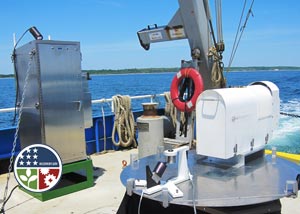Micropulse Lidars Get Boost from Recovery Act
Published: 15 August 2010

The original MPLs transmit in a single polarization state for one averaging period (about 3 seconds) and then the other state for the next averaging period. This separates the data by several seconds, which can lead to ambiguity in the interpretation of the data. As each MPL is refurbished, it will be able to switch polarity with each pulse, essentially recording data simultaneously (separated by .0004 seconds) in separate channels. This reduces much of the uncertainty in the interpretation of the data.
A hybrid system was deployed at the ARM Southern Great Plains (SGP) site in December 2009 for a testing and evaluation period. Based on successful side-by-side operations with the existing MPL and data analysis, plans were implemented to move forward with upgrades to all the MPLs throughout the user facility using funds from the Recovery Act. The first refurbished MPL was shipped to Greenland in May to support the ICECAPS field campaign. On June 1, the hybrid MPL replaced the operational system to collect routine data from the SGP site. Another upgraded MPL was deployed during ship testing for the second ARM Mobile Facility in late June.
 The new data ingest provides the data in much the same format as the original MPL data ingest. Watch this video for an explanation of the data by Rich Coulter, a scientist at Argonne National Laboratory, who supervised the instrument upgrades and ship test.
The new data ingest provides the data in much the same format as the original MPL data ingest. Watch this video for an explanation of the data by Rich Coulter, a scientist at Argonne National Laboratory, who supervised the instrument upgrades and ship test.
The ARM Climate Research Facility is a DOE Office of Science user facility. The ARM Facility is operated by nine DOE national laboratories, including .
Keep up with the Atmospheric Observer
Updates on ARM news, events, and opportunities delivered to your inbox
ARM User Profile
ARM welcomes users from all institutions and nations. A free ARM user account is needed to access ARM data.


















